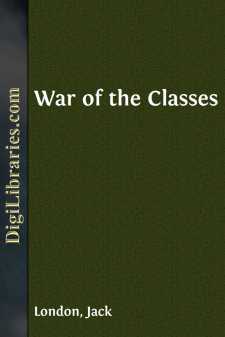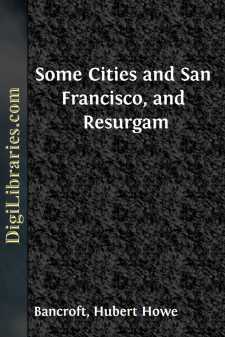Non-Classifiable
- Non-Classifiable 1768
Non-Classifiable Books
Sort by:
by:
Jack London
THE CLASS STRUGGLE Unfortunately or otherwise, people are prone to believe in the reality of the things they think ought to be so. This comes of the cheery optimism which is innate with life itself; and, while it may sometimes be deplored, it must never be censured, for, as a rule, it is productive of more good than harm, and of about all the achievement there is in the world. There are cases where...
more...
CHAPTER I WAR AND THE NATIONS Because the question is widely discussed, whether peace throughout the world may be attained by the friendly co-operation of many nations, and because a nation's attitude toward this question may determine its future prosperity or ruin, it may be well to note what has been the trend of the nations hitherto, and whether any forces exist that may reasonably be expected...
more...
SOME CITIES AND SAN FRANCISCO There had been some discussion as to improving and beautifying the city of San Francisco prior to the catastrophe of April 18th. Landscape architects had been consulted, proposals considered, and preliminary plans drawn. Therefore when on that day the city was swept by fire, obviously it was the opportune moment for the requisite changes in the rebuilding. For a brief...
more...
EMELIAN THE FOOL In a certain village there lived a mujik, or yeoman, who had three sons; two were clever, but the third was a fool, who was called Emelian. When the good man had reached an extreme old age, he called all his sons to him, and said: “Dear children, I feel that I have not long to live; I therefore leave you house and cattle, which you will divide in equal portions. I also leave you...
more...
by:
William Apess
TO THE WHITE PEOPLE OF MASSACHUSETTS * * * * * The red children of the soil of America address themselves to the descendants of the pale men who came across the big waters to seek among them a refuge from tyranny and persecution. We say to each and every one of you that the Great Spirit who is the friend of the Indian as well as of the white man, has raised up among you a brother of our own and has...
more...
First to appear among the inventions that sparked the industrial revolution in textile making was the flying shuttle, then various devices to spin thread and yarn, and lastly machines to card the raw fibers so they could be spun and woven. Carding is thus the important first step. For processing short-length wool fibers its mechanization proved most difficult to achieve. To the United States in 1793...
more...
I New Orleans, Dec. 1, 1860.—I understand it now. Keeping journals is for those who cannot, or dare not, speak out. So I shall set up a journal, being only a rather lonely young girl in a very small and hated minority. On my return here in November, after a foreign voyage and absence of many months, I found myself behind in knowledge of the political conflict, but heard the dread sounds of disunion...
more...
by:
Thornton Hall
CHAPTER I A PRINCESS OF PRUDES Among the many fair and frail women who fed the flames of the "Merrie Monarch's" passion from the first day of his restoration to that last day, but one short week before his death, when Evelyn saw him "sitting and toying with his concubines," there was, it is said, only one of them all who really captured his royal and wayward heart, that loveliest,...
more...
CHAPTER I. — EARLY LIFE OF COLUMBUS. HIS BIRTH AND BIRTH-PLACE—HIS EARLY EDUCATION—HIS EXPERIENCE AT SEA—HIS MARRIAGE AND RESIDENCE IN LISBON—HIS PLANS FOR THE DISCOVERY OF A WESTWARD PASSAGE TO THE INDIES. Christopher Columbus was born in the Republic of Genoa. The honor of his birth-place has been claimed by many villages in that Republic, and the house in which he was born cannot be now...
more...
THE CONSTRUCTION OF ROPES. Rope, the term being used in its widest construction, is made from almost every pliable material, but is generally composed of hemp, manila, coir, cotton, steel, iron, or copper wire. For the present we will confine ourselves to those having their origin in the vegetable kingdom, and more especially to those made from hemp and manila. These are divided into three classes:—...
more...











